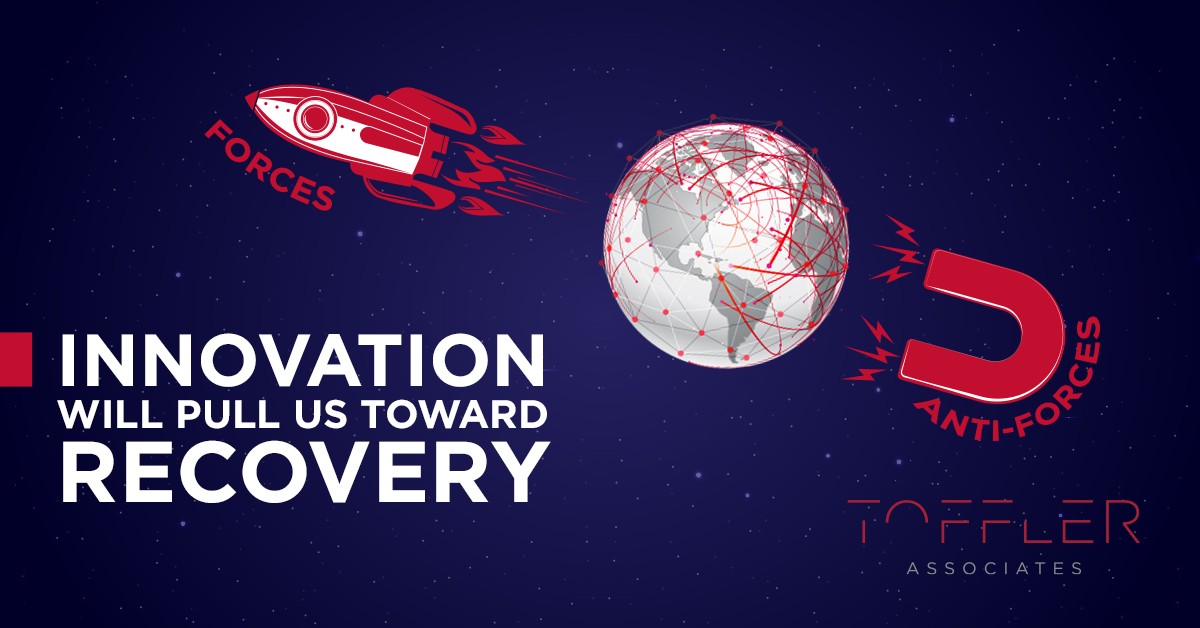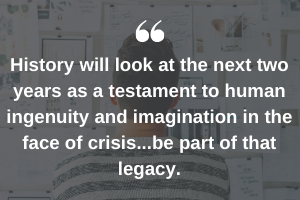Attack COVID-19 Uncertainty with Innovation

If necessity is the mother of invention, then we will likely see a motherlode of innovation over the next couple of years. The necessity is trying to restore economic activity in a constrained public health environment.
As we described in a Toffler Associates’ recent blog about the Phases of Recovery from COVID-19, “The Great Wait” period between the relaxing of social distancing policies and the discovery and global distribution of a vaccine or therapies that lessen the dangers of COVID-19 will be fertile ground for innovation. Business-as-usual practices won’t drive sufficient economic and social activity.
Forces and Anti-Forces During The Great Wait
As our founder Alvin Toffler noted, to understand the future requires understanding the forces and anti-forces at play. While there is generally a desire to restart society’s economic engine (a force) there are constraints put on achieving that goal (anti-forces).
Forces – Every institution in the world – from households to schools to businesses to governments – was operating in a certain pattern and at a certain scale for years; “normal” activity was well defined. The inertia from those patterns of operation are pushing for a fast return to normal along with:
- Economic Health – The low economic activity level during non-essential lockdown is clearly unsustainable; every cog in our economic wheel wants to return to something close to pre-pandemic activity levels.
- Human Interaction Needs – Extreme social distancing is not normal social behavior; most individuals want the freedom to resume their lives in terms of work, school, social activities, recreation, hobbies, travel, etc. The human need to connect and experience is pulling us toward recovery.
- Political Pressures – Society isn’t speaking with one voice; factions that see the public health policies not being worth the economic cost will increasingly push for more activity.
- Opportunism – There will be imaginative entrepreneurs who understand that when the playing field changes, opportunities emerge to fill new needs.
Anti-Forces – On the other side, until the danger of contracting COVID-19 subsides, full-scale economic activity will be held back by:
- Social Distancing Policies – While drastic stay-home orders covering non-essential activities will be relaxed, there will likely be a patchwork of directives that remain from national, state, and local governments.
- Voluntary Social Distancing Behaviors – Since nothing during this period will lessen the transmissibility or severity of the disease, some percent of the population will voluntarily limit their behaviors to minimize their risk of contracting the virus (expect a highly inconsistent set of segments across the spectrum of beliefs).
- Regional and Seasonal Flare-ups – More relaxed policies will undoubtedly produce pockets of flare-ups of the disease, which will lead to geographically-based cycles of stringent and relaxed policies. Additionally, if the disease turns out to be seasonal, a second wave this winter could return us to stricter policies.
- Financial Constraints – Many individuals and organizations will not be able to participate in the economy at desired levels as a result of the financial hardships they are experiencing.
Innovation will need to target which force to accelerate or anti-force to alleviate.
The Innovation Opportunity
The societal pain of low economic activity and new needs creates a necessity for innovation. Specifically, innovations that help get more people safely engaged in normal behaviors during The Great Wait.
To frame the opportunity for virtually any organization: Create an environment that restores economic activities while:
- Making people feel safe to engage in those activities
- Actually keeping them safe from contracting the virus
Note: It’s important not to force pre-pandemic models, that’s an unnecessary design constraint; the goal should be restoring or growing economic value, not simply mimicking past actions.

The more organizations can create real, safe environments (“environment” in the broadest sense of the word, not only a physical space) that make people confident in engaging in activities, the faster we can improve economic activity for the greater good of society.
Innovation Opportunity Example: Retail
Retail is a good place to start looking at the need for innovation as it represents approximately 5.5% of GDP and, according to the National Retail Federation, employs about 42 million Americans throughout the supply chain. This is an important sector for economic recovery but also one that is greatly impacted by social distancing behaviors – the Department of Commerce announced a retail sales drop of 8.7% in March 2020 compared to the same month last year, the largest decline since tracking began in 1992.
It’s unrealistic to think shifting to online commerce will restore the sector. In fact, eMarketer projected just under 11% of retail across all merchant types was online. So, while some retail volume can be made up from channel-shifting (e.g., the share of grocery sales online nearly doubled from 5% to 9% since social distancing started), restoring bricks-and-mortar retail is critical for economic recovery. Retailers will need to design the high hygiene retail experience (i.e., contactless commerce) to entice even the most risk-averse consumers to re-engage.
Innovation should span all aspects of the customer journey, including physical space, products and services, and omnichannel experiences. The necessities of the last two months are already inspiring change: the now commonplace Plexiglas® sneeze guards at checkout counters, curbside pick-up like the concierge service Sam’s Club introduced for seniors and at-risk members, luxury brands that have been slow to adopt digital now leapfrogging traditional brands, and even a camera that tells you when you’re too close to someone.
Of course, this period will also spread the competitive field: the leaders will be the most innovative and have the strongest financial positions to gain ground, a middle group will continually struggle with liquidity and investing in innovation, and a trailing group that may not make it to the next phase of recovery will be in survival mode. JCPenney’s and J. Crew’s bankruptcies could be the tip of a large iceberg.
Innovation will need to extend beyond the direct shopping experience; policies and practices will need innovation. For example, even though there is OSHA guidance for retailers, what if an employee sneezes on a customer or vice versa? (Liability will be confusing.) What disinfecting protocols are effective and economically sustainable? What demands can be placed on customers to keep a safe environment (e.g., masks, screening, asking for health data)?
Don’t Let Your Guard Down
Security and resilience will need innovation too. If there’s one portion of society that capitalizes on innovating at lightning speed when the environment changes, it’s criminals. A focus on crisis management leads to less vigilance because we’re adjusting to new experiences and it’s harder to identify out-of-the-ordinary activity. Also, new infrastructures and practices will have more vulnerabilities than their mature equivalents. As organizations innovate to meet the changing needs of society, being aware of malicious actors and Mother Nature is important; other bad events, either man-made or natural, won’t stop happening because of a global pandemic (there are predictions that this will be an above-average hurricane season; how do we balance social distancing, hurricane evacuation, and emergency shelters?).
How to Innovate for Uncertainty
Even though there is not a precise picture of the environment where these innovations will be used, waiting until there is more clarity will only put organizations further behind. The two steps to get started with innovation are:
- Understand the range of potential futures that may occur and the needs and opportunities they create (trying to predict a single future will increase anxiety and decrease resilience)
- Identify the needs and opportunities that exist across the most futures to determine the safer vs. riskier bets and then link them to the appropriate forces or anti-forces to better target the innovation
It’s clear that The Great Wait will be a time of limited growth unless we amplify the forces and address the anti-forces holding us back. Being proactive with innovation is essential for taking control of the future.
Toffler Associates helps organizations drive innovation for the distant future. Given the level of uncertainty we typically see 5 or 10+ years out is now just 2 months or 2 years out, our approaches for identifying core needs and criteria for innovation apply to today’s environment.
History will look at the next two years as a testament to human ingenuity and imagination in the face of crisis…be part of that legacy. Please contact us if we can help you peer into the future to spark your creativity.
Other COVID-19 resources:
- Categories
- Futures and Foresight
- Strategic Planning


 About the Authors
About the Authors